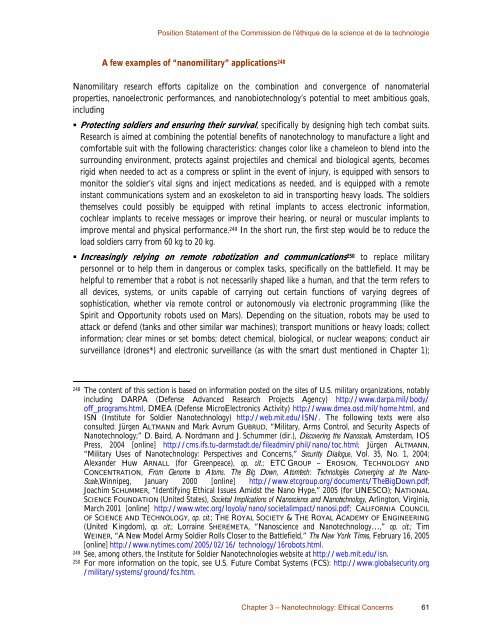A Basis for Action - Commission de l'éthique de la science et de la ...
A Basis for Action - Commission de l'éthique de la science et de la ...
A Basis for Action - Commission de l'éthique de la science et de la ...
You also want an ePaper? Increase the reach of your titles
YUMPU automatically turns print PDFs into web optimized ePapers that Google loves.
Position Statement of the <strong>Commission</strong> <strong>de</strong> l'éthique <strong>de</strong> <strong>la</strong> <strong>science</strong> <strong>et</strong> <strong>de</strong> <strong>la</strong> technologie<br />
A few examples of “nanomilitary” applications 248<br />
Nanomilitary research ef<strong>for</strong>ts capitalize on the combination and convergence of nanomaterial<br />
properties, nanoelectronic per<strong>for</strong>mances, and nanobiotechnology’s potential to me<strong>et</strong> ambitious goals,<br />
including<br />
• Protecting soldiers and ensuring their survival, specifically by <strong>de</strong>signing high tech combat suits.<br />
Research is aimed at combining the potential benefits of nanotechnology to manufacture a light and<br />
com<strong>for</strong>table suit with the following characteristics: changes color like a chameleon to blend into the<br />
surrounding environment, protects against projectiles and chemical and biological agents, becomes<br />
rigid when nee<strong>de</strong>d to act as a compress or splint in the event of injury, is equipped with sensors to<br />
monitor the soldier’s vital signs and inject medications as nee<strong>de</strong>d, and is equipped with a remote<br />
instant communications system and an exoskel<strong>et</strong>on to aid in transporting heavy loads. The soldiers<br />
themselves could possibly be equipped with r<strong>et</strong>inal imp<strong>la</strong>nts to access electronic in<strong>for</strong>mation,<br />
cochlear imp<strong>la</strong>nts to receive messages or improve their hearing, or neural or muscu<strong>la</strong>r imp<strong>la</strong>nts to<br />
improve mental and physical per<strong>for</strong>mance. 249 In the short run, the first step would be to reduce the<br />
load soldiers carry from 60 kg to 20 kg.<br />
• Increasingly relying on remote robotization and communications 250 to rep<strong>la</strong>ce military<br />
personnel or to help them in dangerous or complex tasks, specifically on the battlefield. It may be<br />
helpful to remember that a robot is not necessarily shaped like a human, and that the term refers to<br />
all <strong>de</strong>vices, systems, or units capable of carrying out certain functions of varying <strong>de</strong>grees of<br />
sophistication, wh<strong>et</strong>her via remote control or autonomously via electronic programming (like the<br />
Spirit and Opportunity robots used on Mars). Depending on the situation, robots may be used to<br />
attack or <strong>de</strong>fend (tanks and other simi<strong>la</strong>r war machines); transport munitions or heavy loads; collect<br />
in<strong>for</strong>mation; clear mines or s<strong>et</strong> bombs; <strong>de</strong>tect chemical, biological, or nuclear weapons; conduct air<br />
surveil<strong>la</strong>nce (drones*) and electronic surveil<strong>la</strong>nce (as with the smart dust mentioned in Chapter 1);<br />
248 The content of this section is based on in<strong>for</strong>mation posted on the sites of U.S. military organizations, notably<br />
including DARPA (Defense Advanced Research Projects Agency) http://www.darpa.mil/body/<br />
off_programs.html, DMEA (Defense MicroElectronics Activity) http://www.dmea.osd.mil/home.html, and<br />
ISN (Institute <strong>for</strong> Soldier Nanotechnology) http://web.mit.edu/ISN/. The following texts were also<br />
consulted: Jürgen ALTMANN and Mark Avrum GUBRUD, “Military, Arms Control, and Security Aspects of<br />
Nanotechnology;” D. Baird, A. Nordmann and J. Schummer (dir.), Discovering the Nanoscale, Amsterdam, IOS<br />
Press, 2004 [online] http://cms.ifs.tu-darmstadt.<strong>de</strong>/fileadmin/phil/nano/toc.html; Jürgen ALTMANN,<br />
“Military Uses of Nanotechnology: Perspectives and Concerns,” Security Dialogue, Vol. 35, No. 1, 2004;<br />
Alexan<strong>de</strong>r Huw ARNALL (<strong>for</strong> Greenpeace), op. cit.; ETC GROUP – EROSION, TECHNOLOGY AND<br />
CONCENTRATION, From Genome to Atoms. The Big Down, Atomtech: Technologies Converging at the Nano-<br />
Scale,Winnipeg, January 2000 [online] http://www.<strong>et</strong>cgroup.org/documents/TheBigDown.pdf;<br />
Joachim SCHUMMER, “I<strong>de</strong>ntifying Ethical Issues Amidst the Nano Hype,” 2005 (<strong>for</strong> UNESCO); NATIONAL<br />
SCIENCE FOUNDATION (United States), Soci<strong>et</strong>al Implications of Nano<strong>science</strong> and Nanotechnology, Arlington, Virginia,<br />
March 2001 [online] http://www.wtec.org/loyo<strong>la</strong>/nano/soci<strong>et</strong>alimpact/nanosi.pdf; CALIFORNIA COUNCIL<br />
OF SCIENCE AND TECHNOLOGY, op. cit.; THE ROYAL SOCIETY & THE ROYAL ACADEMY OF ENGINEERING<br />
(United Kingdom), op. cit.; Lorraine SHEREMETA, “Nano<strong>science</strong> and Nanotechnology…,” op. cit.; Tim<br />
WEINER, “A New Mo<strong>de</strong>l Army Soldier Rolls Closer to the Battlefield,” The New York Times, February 16, 2005<br />
[online] http://www.nytimes.com/2005/02/16/ technology/16robots.html.<br />
249 See, among others, the Institute <strong>for</strong> Soldier Nanotechnologies website at http://web.mit.edu/isn.<br />
250 For more in<strong>for</strong>mation on the topic, see U.S. Future Combat Systems (FCS): http://www.globalsecurity.org<br />
/military/systems/ground/fcs.htm.<br />
Chapter 3 – Nanotechnology: Ethical Concerns 61
















